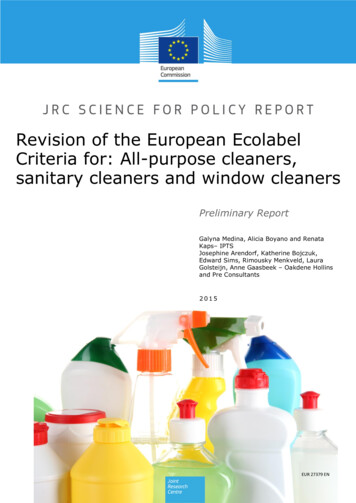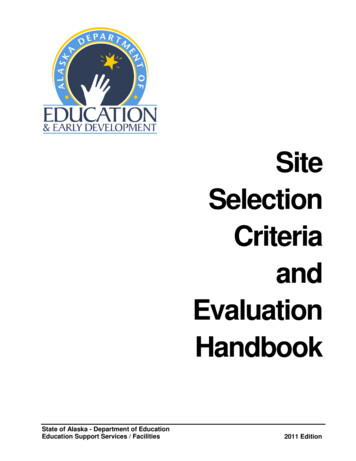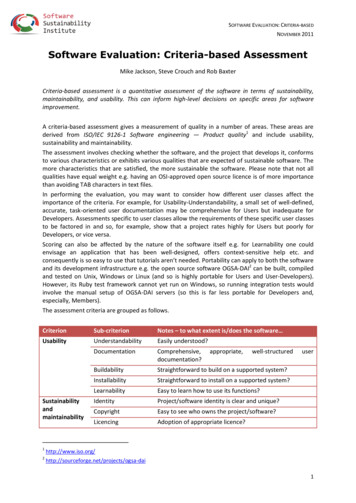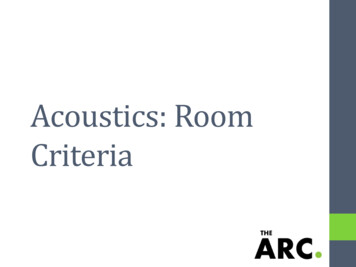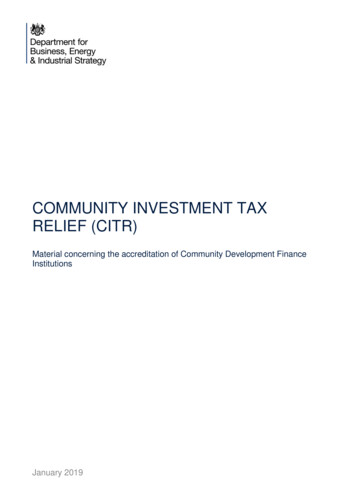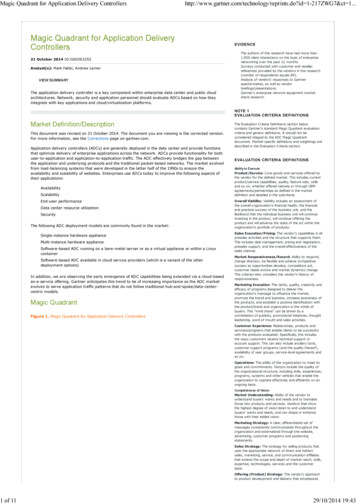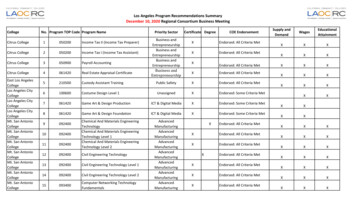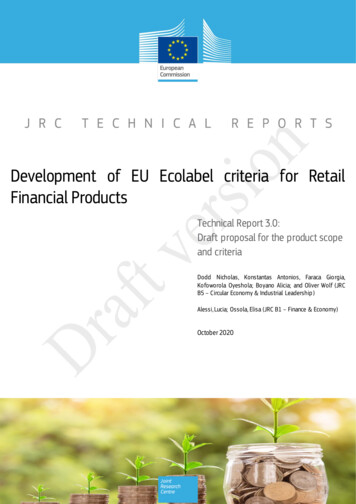
Transcription
Development of EU Ecolabel criteria for RetailFinancial ProductsTechnical Report 3.0:Draft proposal for the product scopeand criteriaDodd Nicholas, Konstantas Antonios, Faraca Giorgia,Kofoworola Oyeshola; Boyano Alicia; and Oliver Wolf (JRCB5 – Circular Economy & Industrial Leadership )Alessi, Lucia; Ossola, Elisa (JRC B1 – Finance & Economy)October 2020EU Ecolabel Criteria for Retail financial products1
This publication is a Technical report by the Joint Research Centre (JRC), the Europe an C om mi ss ion ’sscie nce and knowledge service . It aims to provide evidence-based scientific support t o t h e Eu rope anpolicym aking process. The scientific output expressed does not imply a policy position of the Eu ro pe anC om mission. Ne ither the European C ommission nor any person acting on behalf of the C om mi ssi on i sre sponsible for the use that might be made of this publication. T hi s d raft h as n ot b e e n a dopt e d ore ndorse d by the Europe an C om m ission. Any vie ws e x pre sse d are the pre lim inary vie ws of theC om mission service s and may not in any circumstances be re garded as stating an official position of th eC om mission. The information transmitted is intended only for the Member State or entity to wh i ch i t i saddre ssed for discussions and may contain confidential and/or privileged material.JRC Science Hubhttps://ec.europa.eu/jrcJR C xxxxxEUR x x xxx xxPDFISBN x x x -xx-xx-xxxxx-xISSN x x x x-xxxxdoi:xx.xxxxx/xxxxxxPrintISBN x x x -xx-xx-xxxxx-xISSN x x x x-xxxxdoi:xx.xxxxx/xxxxxxSe ville : European Union, 2020 Europe an Union, 2020The re use of the document is authorised, provided the source is acknowledged and the original meaningor m e ssage of the texts are not distorted. The European Commission shall not be held liable for anyconse quences stemming from the re use.How to cite this re port: Author(s), Title, EUR, doiAll im ages European Union 2019, e xcept: C over page (source: Fotolia.com) and captions wh e re t h esource is specified.
TABLE OF CONTENTSLIST OF TABLES. IIILIST OF FIGURES. IIIABBREVIATIONS AND ACRONYMS . IVFOREWORD.VHOW TO READ THIS REPORT . VII1INTRODUCTION . 12BACKGROUND AND CONTEXT . 22.1Process for developing the EU Ecolabel.22.2Action Plan on Sustainable Finance .22.3Material scope: financial services linked to a product.32.4Summary of the background analysis from the preliminary report .42.4.1 Product group name, scope and defi nitions .42.4.2 Market analysis .52.4.3 Technical analysis.63PRODUCT GROUP NAME, SCOPE AND DEFINITIONS. 93.1Revised proposal .93.2Rationale of the proposed name, scope and definitions. 133.3Outcomes of the 1 st AHWG meeting and main changes in TR2 . 133.4Outcomes of the 2 nd AHWG meeting and stakeholder consultation. 143.5Further research and main changes in the third proposal. 154STRUCTURE AND RATIONALE FOR THE CRITERIA AND CRITERIA AREAS234.1Proposed structure of the criteria. 234.2Rationale of the proposed general text on assessment and verification . 245CRITERIA PROPOSALS . 265.1CRITERION 1 (and 2): Investment in environmentally sustainable economic activities (andCompanies investing in transition and green growth). 265.1.1 Rationale of the proposed criterion text. 375.1.2 Summary of the main changes introduced to criterion 1 in TR2.0. 39i
5.1.35.1.4Outcomes of the 2nd AHWG meeting and stakeholder consultation .40Further research and main changes in the third proposal .445.2CRITERION 3: Exclusions based on environmental aspects.745.2.1 Rationale of the proposed criterion text.795.2.2 Outcomes of the 1st AHWG meeting and main changes in TR2 .795.2.3 Outcomes of the 2 nd AHWG meeting and the stakeholder consultation .805.2.4 Further research and main changes in the third proposal .825.2.5 Summary of the changes made . 1045.3CRITERION 4: Social and governance aspects. 1055.3.1 Rationale of the proposed criterion text. 1085.3.2 Outcomes of the 1st AHWG meeting and main changes in TR2 . 1095.3.3 Outcomes of the 2nd AHWG meeting and the stakeholder consultation. 1105.3.4 Further research and main changes in the second proposal. 1125.4CRITERION 5: Engagement . 1155.4.1 Rationale of the proposed criterion text. 1175.4.2 Outcomes of the 1st AHWG meeting and main changes in the second proposal . 1185.4.3 Outcomes of the 2nd AHWG meeting and stakeholder consultation . 1195.4.4 Further research and main changes in the third proposal . 1205.5CRITERION 6: Measures taken to enhance investor impact . 1295.5.1 Rationale of the proposed criterion text. 1305.5.2 Outcome of the 2 nd AHWG meeting, further research and main changes in the proposal . 1315.6CRITERION 7: Retail investor information. 1405.6.1 Rationale of the proposed criterion text. 1435.6.2 Outcomes of the 1st AHWG meeting and main changes in TR2 . 1435.6.3 Outcomes of the 2nd AHWG meeting and the stakeholder consultation. 1445.6.4 Further research and main changes in the third proposal . 1455.7CRITERION 8: Information appearing on the EU Ecolabel. 1465.7.1 Rational of the proposed criterion text. 1465.7.2 Outcomes of the 1st AHWG meeting and main changes in TR2 . 1475.7.3 Outcomes of the 2nd AHWG meeting and the stakeholder consultation. 1475.7.4 Further research and main changes in the third proposal . 147ii
LIST OF TABLESTable 1 - MSCI analysis:Eligible universe based on EU Ecolabel criterion 1 on equities (large andmid-cap companies). 46Table 2 - MSCI analysis: Eligible universe based on EU Ecolabel criterion 1 on equities (small capcompanies) . 46Table 3 – FIDEAS analysis: Allocation of companies, based on their green revenues, in three pockets . 47Table 4 - Comparison between options 2, 5a and 5b for equity funds. 53Table 5 - Example of calculation of the overall portfolio greenness according to option 5a . 55Table 6 - Example of calculation of the overall portfolio greenness according to option 5b . 56Table 7 - Comparison of the underlying green bond criteria of the EU GBS, CBI and ICMA. 62Table 8 - Comparison of partial exclusion threshold as found in existing national labels. 83Table 9 - Summary of stakeholders’ comments, main focus of JRC research, and outcome of thefurther research for each of the economic activities excluded under criterion 2.1 of theEU Ecolabel (TR2 version). . 86Table 10 - Review of the engagement criteria of existing ecolabels for retail financial products . 121Table 11 - Ownership of companies targeted by Hermes Fund . 128Table 12 - Mapping the investor mechanisms identified in literature onto the EU Ecolabel criteriaproposals . 132Table 13. Impact classes used to group investment products with similar impact characteristics. . 136LIST OF FIGURESFigure 1 - Proportion of Unit-Linked and Profit Participation premiums, based on 2019 Solvency IIdata . 18Figure 2 - Representation of Multi Option Product (MOP) options. 20Figure 3 - Unit-linked and index linked portfolio value by fund composition and category . 22Figure 4 - Growth in annual green bond issuance by issuer type. 60Figure 5 - breakdown of the form of assurance for the green bonds issued in 2019. 60Figure 6 - Green bonds issuers in 2019. 63Figure 7 - Use of proceeds by issuer type in 2019. 64Figure 8 - Relationship of green bond issuance to investment plans and investor exposure. Source:2Degrees Investing Initiative (2018) . 66Figure 9 - Comparison of the power sector green bonds market with 2 degree aligned bonds. Source:2 Degrees Investing Initiative (2018) . 66Figure 10 - How the EU Taxonomy distinguishes different types of economic activities as makingsubstantial contribution to climate change mitigation. 69Figure 11 - How the EU Taxonomy enables companies to transition. 69Figure 12 - CO2 emissions and power generating assets for a sample of major international utilities. 70Figure 13 - Support for climate related resolutions with a 2 oC pathway. 125Figure 14 - Percent of resolutions on climate risks voted in favour, by asset manager,. 126Figure 15 - Mechanisms for achieving investor impact and company impact on parameters related toenvironmental performance and impact. 131Figure 16 Categorisation of retail consumers based on survey results . 137Figure 17 - Relationship of green bond issuance to investment plans and investor exposure. 139iii
ABBREVIATIONS AND COTFPRIIPsRAIFRMSPVSRIUCITSTEECTMITRAlternative Investment FundsAlternative Investment Fund Managers DirectiveBank Identifier CodeClimate Awareness BondsClimate Bonds InitiativeCredit Valuation AdjustmentEuropean CommissionEuropean Economic AreaEnvironment, Social, GovernanceExchange-Traded DerivativesExchange-Traded FundsForum Nachhaltige Geldanlagen (Sustainable Investment Forum Germany)Green Bond PrinciplesGreen Bond StandardGreenhouse GasInternational Capital Markets AssociationInsurance Distribution DirectiveInternational Development Finance ClubInvestment FundInternational Labour OrganizationInsurance Product Information DocumentationJoint Research CentreKey Information DocumentKey Performance IndicatorMultilateral Development BanksMarket In Financial Instrument DirectiveMember StatesNon-Financial Information DirectiveOver-The-CounterOperational Trading FacilityPackaged Retail Investment and Insurance-based ProductsRetail Alternative Investment FundRegulated MarketsSpecial Purpose VehicleSocially Responsible InvestmentUndertakings For Collective Investment In Transferable SecuritiesTransition Energétique Et Ecologique Pour Le Climat(Energy and Ecological Transition for the Climate (France))Total Market IndexTechnical Reportiv
FOREWORDThis report is part of the development of the EU Ecolabel criteria for financial products . Once developed, thecriteria will be adopted through a Commission Decision under the EU Ecolabel Regulation. It summarisesand updates the inputs received and the further research carried out by the working team and serves as aworking document for the EU Ecolabelling Board (EUEB) meeting to be held on 18 November 2020 (virtualmeeting). It takes as its starting point the information available in the Preliminary Report, the First a.eu/product-bureau/product-groups/432/home.The Preliminary Report and the First Technical Report were published in March 2019, and provided thetechnical background for the product group from a legal, political and market context for the first stakeholder(1st AHWG) meeting held in April 2019 in Seville, Spain. The First Technical Report contained draft criteriaproposals which were presented to stakeholders during the 1st AHWG meeting and on which stakeholderswere invited to comment during the consultation period. The comments received from the stakeholders havesubsequently been collated, analysed, and, following further research, addressed in this Second TechnicalReport.The Second Technical Report was published in December 2019, and provided the technical background forthe product group for the second stakeholder (2nd AHWG) meeting held in March 2020 (virtual meeting).The Second Technical Report contained draft criteria proposals which were presented to stakeholders duringthe 2nd AHWG meeting and on which stakeholders were invited to comment during the consultation period.The comments received from the stakeholders have subsequently been collated, analysed, and, followingfurther research, addressed in this Third Technical Report.This Third Technical Report provides an update to the set of criteria proposals contained in the SecondTechnical Report based on additional research, and information provided by stakeholders including thesubgroup set up to address issues on criterion 1 related to the thresholds on the green investment portfolioand EU taxonomy-eligible economic activities. This report also includes an update of the initial scope anddefinitions.v
HOW TO READ THIS REPORTThe current revised third technical report provides an update on the criteria development,based on new information collected during the process and provided by the involved parties (i.e.through stakeholders' discussion at the 2nd AHWG meeting, further stakeholder inputs followingthe meetings and additional desk research).This report consists of the following sections:---Section 1 - Introduction: describing the goal and content of the document, and thesources of information used.Section 2 - Background and Context: presenting the process for developing EUEcolabel criteria, the Action Plan on Sustainable Finance, the material scope of thecriteria, as well as summarising the main conclusions obtained in the PreliminaryReport.Section 3 - Product group name, scope and definitions: including the updated scopeand definitions for the product group of financial products.Section 4 - Structure and rationale for the criteria and criteria areas: providing anoverview of how the criteria set could be configured. The criteria set also includesrequirements on the type of documentation required to show compliance with thecriteria that shall be provided by applicants to the EU Ecolabel Competent Bodies.Section 5 - Criteria proposal: presenting the second draft of the proposed EU Ecolabelcriteria for financial services. The proposal is written in a blue box and subs equently arationale is given. Under each criterion, discussions are chronologically presented underthe following headings:o Summary of the rationale and technical data discussed in the PreliminaryReport and the first stakeholder questionnaire that led to the first criteriaproposal, presented in the 1st AHWG meeting.o The outcomes of and suggestions made by the stakeholders during the 1 stAHWG meeting and the subsequent commenting period.o Further research carried out on the points addressed by the stakeholders or anyother point of relevance and main changes of the criterion in the secondproposal.Background on the EU Taxonomy and a comparison between the 1 st and 2nd (revised) criteriaproposals are provided in Annexes 1 and 2 respectively.Should stakeholders require more information about the EU Ecolabel criteria proposed in theSecond Technical Report, they are kindly request to download it from the project ureau//product-groups/432/documents.EU Ecolabel Criteria for Retail financial productsvii
1INTRODUCTIONThe main objective of this project is the development of EU Ecolabel criteria for the financialproducts group. The study is being carried out by the Circular Economy & Industrial Leadershipand the Finance & Economy Units of the Joint Research Centre (JRC) of the EuropeanCommission. The work is being developed for the European Commission's Directorate-Generalfor the Environment (DG ENV) and in collaboration with the Directorate-General for Financ ialStability, Financial Services and Capital Markets Union of the European Commission (DGFISMA).The EU Ecolabel criteria are designed to promote the use of the most environmentally friendlyproducts as articulated by the Regulation on the EU Ecolabel (Regulation (EC) No 66/2010 ofthe European Parliament and of the Council of 25 November 2009 on the EU Ecolabel),hereafter, the 'EU Ecolabel Regulation'. According to Article 2, this Regulation applies to‘products’ (either goods or services) that are supplied for distribution, consumption or us e onthe Community market.The main purpose of the technical report is to summarise the results of the prior analysis andpropose appropriate and updated criteria in this Third Technical Report to serve as a backgrounddocument for discussion with stakeholders during the EUEB meeting.This technical report is supported and complemented by the Preliminary Report1 published inMarch 2019. The Preliminary Report includes the scope and definition, market analysis, andtechnical analysis. Moreover, the First Technical Report 2 was published in March 2019 andformed the basis for the 1st AHWG meeting which took place in April 2019. Finally, the SecondTechnical Report3 was published in December 2019 and formed the basis for the 2 nd AHWGmeeting which took place in March 2020.1Preliminary Report. EU Ecolabel criteria for Financial Products. March 2019. Available at:https://susproc.jrc.ec.europa.eu/product bureau//sites/default/files/contentype/product group %20Financial%20Products Final%20consultation.pdf .2First T echnical report EU Ecolabel Financial Products. March 2019. Available at:https://susproc.jrc.ec.europa.eu/product bureau//sites/default/files/contentype/product group %20Financial%20Products Final%20consultation.pdf .3 Second T echnical report EU Ecolabel Financial Products. December 2019. Available at:https://susproc.jrc.ec.europa.eu/product -bureau//sites/default/files/202002/20191220 EU Ecolabel FP Draft Technical Report 2 -0.pdf .EU Ecolabel Criteria for Retail financial products1
BACKGROUND AND CONTEXT22.1Process for developing the EU EcolabelThe typical process of developing the EU Ecolabel criteria for any product group is set out inArticle 7 of and Annex I to the EU Ecolabel Regulation. This entails the management of aprocess of stakeholder consultation to be supported by the development of the followingdocuments by the party which is leading the process: (1) a Preliminary Report; (2) a proposalfor draft criteria; (3) a Technical Report in support of the proposal for draft criteria; (4) a FinalReport; and; (5) manuals for potential users of the EU Ecolabel and Competent Bodies (CBs),and for authorities awarding public contracts.Moreover, the EU Ecolabel Regulation also stipulates that a minimum of two AHWG meetingsshall be held along the criteria process, the first of which took place in April 2019 and thesecond which took place in March 2020. At the meetings the material contained in thePreliminary Report and the two Technical Reports were discussed. The feedback from thesemeetings, together with associated rounds of written consultations and multilateral consultationsare used to further adapt the scope and criteria proposals.This Third Technical Report has been drafted in accordance with Article 7 of the EU Ec olabelRegulation and will be updated during the criteria development process based on newinformation, stakeholder feedback and input from the EUEB meeting and the writtenstakeholder consultation. The Final Technical Report will incorporate all relevant scientificarguments substantiating the final criteria proposal.2.2Action Plan on Sustainable FinanceSustainability has long been at the heart of the European project and the European Union (EU)is fully committed to reaching the EU 2030 climate and energy targets and to mainstreamingsustainable development into EU policies. Achieving EU sustainability goals requires majorinvestments. A substantial part of these financial flows will have to come from the privatesector and this requires redirecting private capital flows towards more sustainable inves tmentsas well as comprehensively rethinking the European financial framework.In this context, in December 2016, the European Commission established a High-Level ExpertGroup (HLEG) to develop an overarching and comprehensive EU strategy on sustainablefinance. This group published its final report in January 2018. As a follow -up, on 7 March 2018,the European Commission published an Action Plan: Financing Sustainable Growth (hereafter,the 'Action Plan') 4. This Action Plan puts forward 10 actions whose main objectives are to:1. Reorient capital flows towards sustainable investments to achieve sustainable andinclusive growth;2. Manage financial risks stemming from climate change, resource depletion,environmental degradation and social issues; and3. Foster transparency and long-termism in financial and economic activity.Action 2 of the Action Plan refers to “Creating standards and labels for green financialproducts”. The Action Plan recognised that “labelling schemes can be particularly useful forretail investors who would like to express their investment preferences on sustainable activities[and] could facilitate retail investors' choice [ ]”. Hence, the Commission “committed toexplore the use of the EU Ecolabel framework for certain financial products, to be applied onc ethe EU sustainability taxonomy is adopted”.4European Commission. 2018. Communication from the Commission to the European Parliament, the European Council, theCouncil, the European Central Bank, the European Economic and Social Committee and the Committee of the Regions Action Plan:Financing Sustainable Growth. Available from: i CELEX:52018DC0097EU Ecolabel Criteria for Retail financial products2
This action was a follow-up to the specific recommendations of HLEG to establish “a voluntaryEuropean green label to spur market growth and enable retail investors to identify products thatfinance the climate and ecological transition”. The HLEG report further recommended that “theCommission should develop a voluntary EU green label for green themed funds [which] shouldinclude specifications based on the use of the EU sustainable taxonomy”.Hence, the link between the EU Ecolabel criteria for financial products and the EU Taxonomywas already contained in the HLEG recommendations and the Action Plan. The ImpactAssessment accompanying the Taxonomy proposal also recognises that the EU Ecolabel is oneof the potential uses of the Taxonomy and is thus one mechanism through which the Taxonomywill have an impact:“The use of the EU taxonomy for (financial) product standards and labels would improveenvironmental integrity of green investments within as well as outside the EU (as the taxonomywould also apply to EU investors investing globally). As such, it would help to minimise therisk of greenwashing and avoid the negative environmental impacts from investing in assets thatare not in line with the EU sustainability goals”. Annex 2 provides more details about theTaxonomy.A further follow-up is the preparation of a Commission Decision defining criteria to be fulfilledby financial products in order to qualify for the EU Ecolabel. This happens in the framework ofthe EU Ecolabel Regulation, which provides guidance as to how criteria should be developedand implemented for products and services. The EU Ecolabel is a voluntary award schemeintended to promote products with a reduced environmental effect during their entire life c yc leand to provide consumers with accurate, non-deceptive, science-based information on theenvironmental impact of products. It is a part of a broader EU Action Plan on SustainableConsumption and Production and Sustainable Industrial Policy (European Commisison, 2008) .This Action Plan was already adopted by the European Commission on 16 July 2008 and linksthe EU Ecolabel to other EU policies such as Green Public Procurement (GPP), the Ec odesignof energy-related products, and the EU Action Plan for the Circular Economy.2.3Material scope: financial services linked to a productAccording to the EU Ecolabel Regulation, the label may be awarded to "goods and services"which are supplied for distribution, consumption or use on the Community market whether inreturn for payment or free of charge. Financial products fall within the scope of the EU EcolabelRegulation where they can be considered as services for distribution or use. Consequently, theEU Ecolabel will be awarded to the financial service being provided by the manufacturerof the green financial product, rather than to the financial product. However, the EU Ecolabellogo can figure on the promotional material of the financial product itself.Given the inclusion of savings accounts and deposits in the expanded scope of this revisedcriteria proposal due to their relevance to consumers and their market significance in terms ofhousehold money, there is a need to provide a service definition for this additional financialproduct.Consequently, the generic financial service definition will need to be clearly specified to coverthe two groups
The Preliminary Report and the First Technical Report were published in March 2019, and provided the technical background for the product group from a legal, political and market context for the first stakeholder (1st AHWG) meeting held in April 2019 in Seville, Spain. The First Technical Report contained draft criteria
